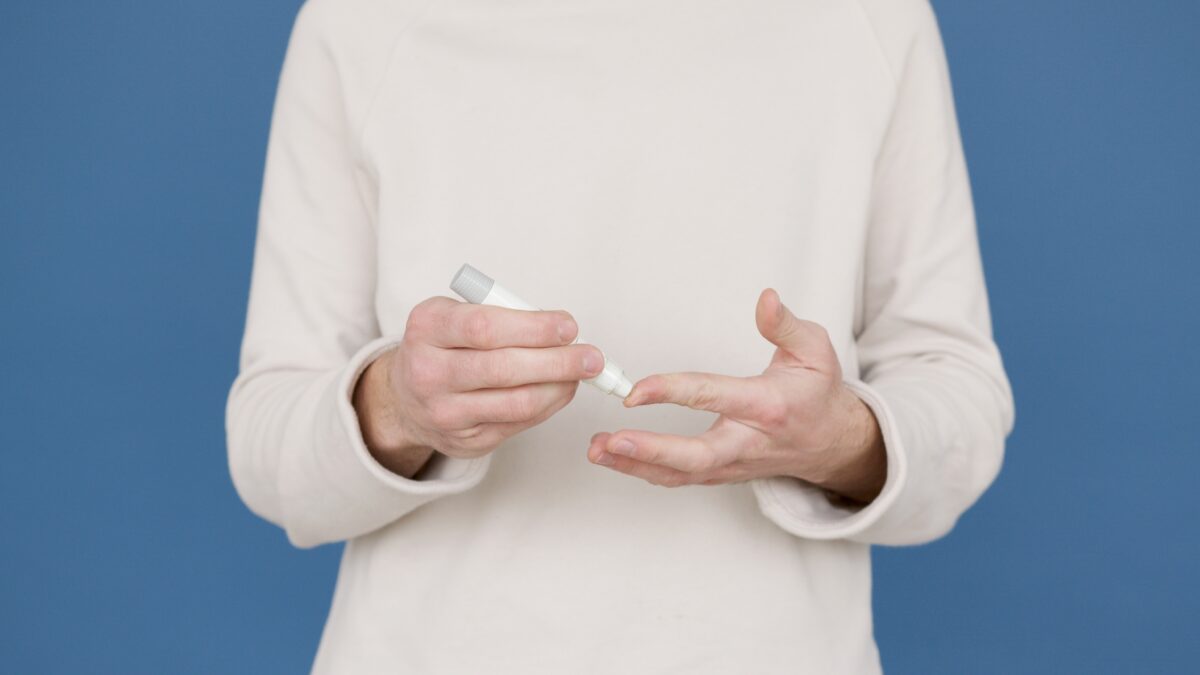Blood Sugar 101 – Why is My Cholesterol Important For My Diabetes?

Are you getting nightmares about your diabetes and cholesterol? Both these conditions can pose serious health risks. Moreover, high blood sugar levels may also lead to high cholesterol. But you can lead a healthy life by keeping both under control.
Read on to know more about the relationship between diabetes and cholesterol levels. Plus, get to know how to manage your blood sugar and cholesterol to stay fit.
What is Cholesterol and Why Should You Monitor It?
Cholesterol is a fatty substance made by your liver. It is present naturally in your blood and circulates in your body.
Cholesterol is an essential component of your body because every cell uses it. It helps your body make Vitamin D and some hormones. It’s also a crucial component of bile.
There are two types of cholesterol in your body: LDL cholesterol and HDL cholesterol. LDL stands for low-density lipoprotein and HDL refers to high-density lipoprotein. While the former is bad cholesterol, the latter is good.
Now, what exactly do these mean? LDL cholesterol travels from your liver to the cells that need it. But higher levels of LDL can cause a build-up of fatty materials in your artery walls, restricting your blood flow. That leads to high blood pressure, increasing the chances of cardiovascular disease.
HDL cholesterol, however, travels from your cells back to the liver where they get broken down. Thus, it is called good cholesterol.
Now you know that high levels of LDL cholesterol lead to heart disease. It increases the chances of heart attack and stroke. That’s why you should monitor your cholesterol levels to ensure you are healthy.
What is Diabetes?
Diabetes is a condition when your blood sugar levels become too high. It happens when your body doesn’t produce enough insulin or the insulin produced isn’t effective.
Your pancreas produces insulin. This hormone helps the glucose in your blood to enter the cells to provide energy. But, this system doesn’t work if you have diabetes. Thus, there is excess glucose in your blood.
There are two types of diabetes: Type 1 and Type 2.
In Type 1 diabetes, your body’s immune system destroys the cells that produce insulin. While in Type 2 diabetes, your body doesn’t produce enough insulin or the insulin produced doesn’t work.
A blood test can help you detect diabetes. You can’t reverse type 1 diabetes. But you can manage type 2 diabetes with a healthy diet, exercise, and other lifestyle changes.
Diabetes can lead to eye problems, digestive and kidney diseases, and other health issues. So, you should follow a healthy lifestyle and monitor your blood glucose levels regularly if you are diabetic.
How are Cholesterol and Diabetes Related?
If you have diabetes, you are at a greater risk of developing high cholesterol. Let’s see how that works.
Research shows that diabetes can lead to a condition called diabetic dyslipidemia. It reduces the level of HDL cholesterol (good cholesterol) and increases the level of LDL cholesterol ( bad cholesterol) in your body. Thus, the walls of your arteries get blocked, increasing your risk of stroke and heart attacks.
Apart from that, the LDL particles in your body are smaller and denser when you have diabetes. So they easily invade the walls of your blood vessels, causing blocks in your arteries.
A diabetic patient develops insulin resistance. You know that insulin helps in the absorption of glucose to your cells. But it also prevents the breakdown of fats into fatty acids by a process called lipolysis.
Insulin resistance increases the breakdown of fats in your body, increasing the lipid particles in your blood. These include the harmful LDL particles which form plaques in your arteries.
Diabetes also damages the linings of your arteries. So, the LDL particles can easily stick to them, causing blocks.
Even people with regulated glucose levels can develop diabetic dyslipidemia. But, your risk of developing high cholesterol increases if you don’t monitor and regulate your blood sugar level.
How to Manage Cholesterol and Diabetes?
Living with diabetes and cholesterol can be challenging. It’s crucial to manage your glucose and blood cholesterol levels to lead a healthy life. A healthy diet and regular physical activity will keep your blood sugar and cholesterol levels in check.
Here are some top tips to keep your blood sugar and cholesterol levels healthy.
1. Watch your blood sugar levels and cholesterol numbers carefully
A blood test will help you monitor your glucose and cholesterol levels. The American Heart Association recommends that adults above the age of 20 should check their cholesterol levels every 4 to 6 years.
But if you have diabetes, your doctor will ask you to check your cholesterol levels more frequently. That’s because diabetic patients are at a greater risk of developing heart diseases.
The National Library of Medicine suggested the following cholesterol levels as healthy for adults.
- Total cholesterol: 125-200 mg/dl
- LDL cholesterol: less than 100 mg/dl
- HDL cholesterol: 40 mg/dl for males and 50 mg/dl for females
The normal blood sugar level while fasting ranges from 70 to 99 mg/dl. And it should be less than 140 mg/dl after 2 hours of having your meal.
2. Take your medications as per schedule
Sometimes, diet and exercise might not be enough to lower your cholesterol. Thus, your doctor may prescribe medicines to maintain healthy cholesterol levels.
Make sure you take your medications on time. Missing them might lead to complications. Some medicines your doctor might prescribe to reduce cholesterol levels include:
- Statins
- Fibrates
- Bile acid resins
- PCSK9 inhibitors
Your physician might also advise you to take insulin to keep your blood glucose levels in check.
Are you worried about the side-effects of your medicines? Check out these questions you must ask your pharmacist while buying any medicine.
3. Exercise daily
Regular exercise can help you lead a healthy life and keep your diabetes and cholesterol under control. You can engage in some aerobic exercise daily. It involves any physical activity like brisk walking, running, jogging, cycling, or swimming. That will help you maintain a healthy weight and also lower your blood sugar and cholesterol levels.
The American Diabetes Association suggests people with diabetes exercise for 30 minutes at least 5 days a week. That will also help maintain healthy cholesterol levels.
The Center for Disease Control and Prevention also recommends 2 hours and 30 minutes of physical activity every week. What if you don’t get enough time? Well, you can make exercise a part of your daily chores. For example, take the stairs instead of the elevator or walk to the grocery store.
4. Try aerobic breathing exercises
Aerobic breathing exercises increase your breathing and heart rate. Thus, the oxygen supply to your body increases. As a result, your muscles get more oxygen to fuel their activity.
When your muscles are active, they draw in glucose from your blood. That reduces your blood sugar levels, thereby lowering the risk of dyslipidemia.
5. Eat healthy meals
Diet impacts your health more than anything. A healthy diet can help eliminate your cholesterol problems.
A Cambridge University study showed that LDL cholesterol levels decreased by 22 to 33% in people having a controlled diet. Their diet contained reduced saturated fats and included healthy foods like nuts.
Foods to consider avoiding
If you have diabetes and are trying to control cholesterol, you should avoid processed foods with added salt and sugar. Stay away from foods with saturated fats like meat, cheese, and dairy desserts. They are high in cholesterol and can increase the risk of heart disease.
Foods to consume regularly
Including whole grains and fiber rich foods in your diet can maintain a healthy weight and lower your cholesterol levels.
You can have more of:
- Oats
- Blueberries
- Flax seed
- Soybeans
- Avocado and
- Salmon
Foods with soluble fiber prevent your digestive tract from absorbing cholesterol. So, make sure you have more whole grains, beans, and fruits like bananas and oranges in your diet.
The CDC recommends you consume more foods with unsaturated fats like nuts, avocado, and vegetable oils like olive oil. These foods help manage high levels of LDL cholesterol while increasing HDL or good cholesterol levels.
6. Reduce your alcohol and cigarette intake
Smoking leads to increased risk of heart disease and stroke. So if you are diabetic, it is better to quit smoking.
You should also lower your alcohol consumption. It makes you overweight and increases your LDL level. Thus, you develop a higher risk of heart diseases.
The CDC recommends females have no more than 1 glass of alcoholic beverage per day while males shouldn’t have more than 2.
Over to you
Living with both high cholesterol and diabetes is challenging. But, you can protect your health by adopting a healthy lifestyle. Follow the tips listed above and don’t forget to stay in touch with your physician.
Confused about where to start? Health Hero Pharmacy can guide you to stay at the peak of good health.
Connect with our expert pharmacists today to take care of your overall health.
Sources
- https://www.heart.org/en/health-topics/diabetes/diabetes-complications-and-risks/cholesterol-abnormalities–diabetes
- https://www.healthline.com/health/high-cholesterol/treating-with-statins/guide-to-diabetes-and-high-cholesterol#diabetes-and-high-cholesterol
- https://www.medicalnewstoday.com/articles/cholesterol-and-diabetes
- https://www.webmd.com/cholesterol-management/high-cholesterol-diabetes




